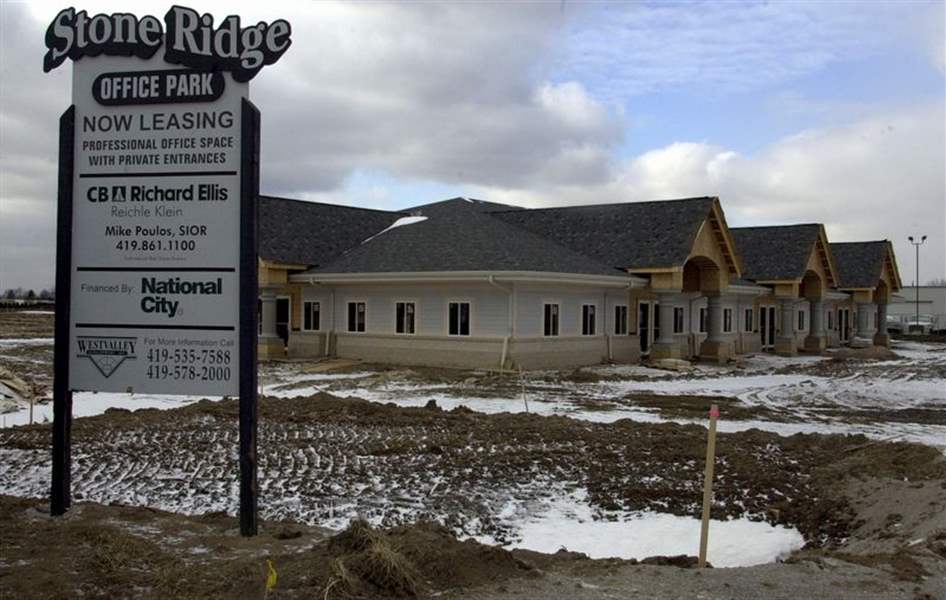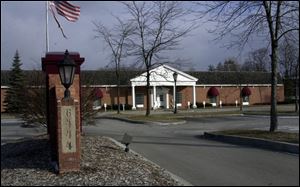
Office, factory vacancies rise
2/9/2003
West Valley Development recently completed a ready-to-finish shell of an office building in Perrysburg.
blade

The demise of Cavista Corp. left its headquarters vacant.
As the economy has slowed business expansion plans and has prompted others to cut back, vacancy rates in metro Toledo office and industrial buildings have jumped.
As a result, landlords for the first time in several years are offering incentives to potential tenants. The possibility of war with Iraq, which could further hinder the U.S. economy, means more such deals and unused space may be on tap this year.
“The office market has been soft and it's been slow,” said Stephen Welly, president of Rudolph/Libbe Properties in Sylvania Township. “And, to be frank, the industrial market has been even softer.”
Eleven percent of the nearly 80 million square feet of industrial space in the Toledo area is vacant, more than double the record lows of five years ago, according to Michael Realty Co., a Toledo commercial real estate firm. Speculative space sits empty at reduced prices.
That meant rent prices hit a record low. The average asking rent dropped in the last six months of last year to $2.89 a square foot per year from $3.17 for the first half of the year, reported CB Richard Ellis, Reichle Klein, a Springfield Township commercial real estate firm. A further decline is possible, the firm said.
Several area industrial sites were closed last year, including Faurecia Exhaust System, Inc.'s nearly 1 million-square-foot site on Matzinger Road; a former Advance Packaging facility on Airport Highway, with 150,000 square feet; and a 28,000-square-foot building that had housed a Dana Corp. operation on American Road.

West Valley Development recently completed a ready-to-finish shell of an office building in Perrysburg.
The Michael Realty report covers all industrial buildings from the Michigan border south to Perrysburg. But the latest report does not reflect the more than 1 million square feet demolished at the Toledo Jeep Parkway factory last year.
“Unfortunately for many of the vacancies, the price is not the reason there's limited activity,” said Rob Gemerchak, a partner with Michael Realty. “There's just a lack of demand right now.”
The slowdown is not limited to the Toledo area, as businesses nationwide are limiting expanding or moving, he said.
Nationally, industrial vacancy is 10 percent, up from 9 percent a year earlier, according to the Society of Industrial and Office Realtors in Washington.
John Green, an industrial specialist for the local office of CB Richard Ellis, said the economy is just one reason for industrial vacancies. Another is that what's available locally is mostly older, outdated buildings that manufacturers generally don't want, he said.
The economy has taken a similar toll on office space. The vacancy rate in suburban offices climbed to more than 17 percent last year from 13 percent the previous year, according to Michael Realty.
Contributing to that increase were the demise of Cavista Corp. of Sylvania; final moves from Fifth Third Bank's acquisition of Capital Bank; and Eaton Corp.'s vacating of space. Those three opened up nearly 200,000 square feet of prime offices.
Unused space in downtown and near-downtown office buildings hovered at about 30 percent, according to Michael Realty. The firm accounts for buildings with more than 5,000 square feet but excludes medical, government, and solely owner-occupied buildings.
Rents for all types of office space remained steady last year from the previous year, said Marty Gallagher, a partner and office specialist with Michael Realty, as landlords resisted discounting and instead offered rent abatements and improvements.
Prices for offices in prime locations remained steady at $15 to $23 a square foot per year, about $12 to $15 a square foot for slightly older space, and under $11 for buildings that need work, said Mr. Gallagher.
“We haven't seen anything really skyrocket or go down significantly,” he said. “I think everyone has just decided to weather the storm.”
Building owners are, however, willing to sweeten offers.
“Are landlords offering incentives? Yes,” said Mike Poulos, an office expert locally for CB Richard Ellis.
“They're offering perhaps additional [renovations] or maybe one month free rent, maybe two months. It varies from landlord to landlord and market to market.”
Most of the empty office space is relatively small, 1,000 to 2,500 square feet, often resulting from larger companies closing satellite offices, Mr. Poulos said.
However, some areas in metro Toledo, such as Arrowhead Park in Maumee, have improved office occupancy. Arrowhead vacancies have dropped to 16 percent from more than 22 percent 18 months ago. The CB Richard Ellis report states more vacancy is possible in Arrowhead, given persistent rumors of departures.
“I think overall we're in pretty good shape,” Mr. Poulos said. “Compared to what's going on nationally, it could be a heck of a lot worse than it is.”
Nationally, office vacancy is about 15 percent, up from 12 percent a year ago, according to the Society of Industrial and Office Realtors.
Despite sobering economic reports and continuing uncertainty about war with Iraq, commercial real-estate experts are cautiously optimistic that business will pick up this year.
“We're already seeing a little more activity and more inquiries on our land sites,” said Mr. Welly, of Rudolph/Libbe.
Michael Realty predicts improvement too, but expects landlord incentives to tenants to continue.
Craig Harris, president of West Valley Development, Inc., in Toledo, said his firm built the shell of a 10,000-square-foot office building on Commerce Drive in Perrysburg and can have the interior finished in 45 days after leases are signed.
“We decided to do this because we've lost several prospective tenants who needed to move in quickly,” he said, noting that plans call for two more such buildings. “It's a little bit of a risk, but we're optimistic we'll slowly come out of this recession.”